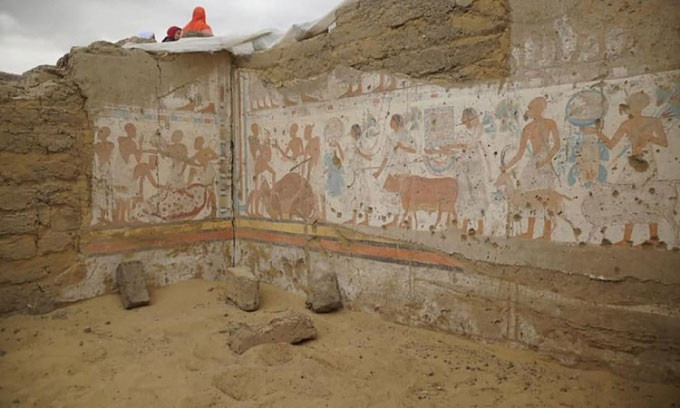The Egyptian Ministry of Tourism and Antiquities announced on October 30 the discovery of the tomb of Ptah-M-Wea, who held several important positions during the reign of Pharaoh Ramses II.
Mostafa Waziri, Secretary General of the Supreme Council of Antiquities, stated that the Archaeology Department of Cairo University discovered the tomb of Ptah-M-Wea during an excavation in the Saqqara area of Giza. Ptah-M-Wea was the official in charge of the treasury during the reign of Pharaoh Ramses II, who ruled Egypt for 66 years from 1279 to 1212 BC.

A decorated wall with many carvings inside the tomb of Ptah-M-Wea. (Photo: Egyptian Ministry of Tourism and Antiquities)
The tomb is located within a site that includes the tombs of high-ranking officials from the 19th dynasty and additional structures for the burial complex of the 18th dynasty, the most significant of which is the tomb of General Horemheb. According to Waziri, Ptah-M-Wea was not only responsible for the treasury but also oversaw livestock and offerings at the temple of Ramses II in Thebes.
Ola al-Ajezy, the head of the archaeological team at Cairo University, shared that the cemetery was constructed in a distinctive tomb-temple style. This style features an entrance in the form of a large building, followed by one or more small courtyards. The end of the tomb includes temples dedicated to goddesses on the west side, topped by a small pyramid. The entrance to the tomb is made of stone, adorned with numerous images of the tomb’s owner. The most distinctive image depicts a scene of offering sacrifices and butchering a calf.
Inside the tomb, there are many columns named Osiria, after the god Osiris, which symbolizes the connection between heaven and earth. The ancient Egyptians believed that these columns would reach up to paradise. Through them, the god Ra, the deity governing heaven, would connect with Osiris, the god managing the underworld.


















































